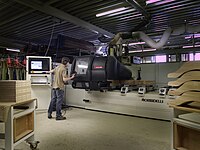
Photo from wikipedia
Cutting condition monitoring is essential for managing the operation of machine tools in manufacturing. The t-distributed stochastic neighbor embedding (t-SNE) method has been adopted to learn the underlying relationship between… Click to show full abstract
Cutting condition monitoring is essential for managing the operation of machine tools in manufacturing. The t-distributed stochastic neighbor embedding (t-SNE) method has been adopted to learn the underlying relationship between cutting parameters in a manifold. This article focuses on cutting force embedding in the t-SNE, termed Ft-SNE, for applications in feature selection to achieve better performance for condition monitoring of machine tools. In the method, the measured vibration signals are used to build the fundamental feature space in the high-dimensional space with cutting force signals being introduced to improve its separability. Further analysis is performed to optimize the classification performance of the Ft-SNE by selecting the appropriate weighting coefficient by minimizing the Kullback–Leibler (KL) divergence. The experiments were implemented on a three-axis vertical machining center. Vibration signals and cutting force signals under different cutting conditions were collected from the vertical machining center. The visualization results of the Ft-SNE and t-SNE were analyzed in low-dimensional space. By introducing the tangential cutting force, the classification performance is improved with classification evaluation indicators being around 98%, with an improvement of over 41% compared to the traditional t-SNE for cutting condition classification in machining process.
Journal Title: IEEE Transactions on Instrumentation and Measurement
Year Published: 2022
Link to full text (if available)
Share on Social Media: Sign Up to like & get
recommendations!